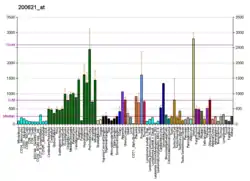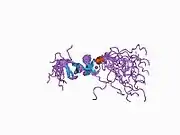| CSRP1 | |||||||||||||||||||||||||||||||||||||||||||||||||||
|---|---|---|---|---|---|---|---|---|---|---|---|---|---|---|---|---|---|---|---|---|---|---|---|---|---|---|---|---|---|---|---|---|---|---|---|---|---|---|---|---|---|---|---|---|---|---|---|---|---|---|---|
 | |||||||||||||||||||||||||||||||||||||||||||||||||||
| Identifiers | |||||||||||||||||||||||||||||||||||||||||||||||||||
| Aliases | CSRP1, CRP, CRP1, CSRP, CYRP, D1S181E, HEL-141, HEL-S-286, cysteine and glycine rich protein 1 | ||||||||||||||||||||||||||||||||||||||||||||||||||
| External IDs | OMIM: 123876 MGI: 88549 HomoloGene: 37874 GeneCards: CSRP1 | ||||||||||||||||||||||||||||||||||||||||||||||||||
| |||||||||||||||||||||||||||||||||||||||||||||||||||
| |||||||||||||||||||||||||||||||||||||||||||||||||||
| |||||||||||||||||||||||||||||||||||||||||||||||||||
| |||||||||||||||||||||||||||||||||||||||||||||||||||
| |||||||||||||||||||||||||||||||||||||||||||||||||||
| Wikidata | |||||||||||||||||||||||||||||||||||||||||||||||||||
| |||||||||||||||||||||||||||||||||||||||||||||||||||
Cysteine and glycine-rich protein 1 is a protein that in humans is encoded by the CSRP1 gene.[5][6][7]
CSRP1 is a member of the CSRP family of genes encoding a group of LIM domain proteins, which may be involved in regulatory processes important for development and cellular differentiation. The LIM/double zinc-finger motif found in CRP1 is found in a group of proteins with critical functions in gene regulation, cell growth, and somatic differentiation Other genes in the family include CSRP2 and CSRP3.[7]
References
- 1 2 3 GRCh38: Ensembl release 89: ENSG00000159176 - Ensembl, May 2017
- 1 2 3 GRCm38: Ensembl release 89: ENSMUSG00000026421 - Ensembl, May 2017
- ↑ "Human PubMed Reference:". National Center for Biotechnology Information, U.S. National Library of Medicine.
- ↑ "Mouse PubMed Reference:". National Center for Biotechnology Information, U.S. National Library of Medicine.
- ↑ Liebhaber SA, Emery JG, Urbanek M, Wang XK, Cooke NE (Aug 1990). "Characterization of a human cDNA encoding a widely expressed and highly conserved cysteine-rich protein with an unusual zinc-finger motif". Nucleic Acids Res. 18 (13): 3871–9. doi:10.1093/nar/18.13.3871. PMC 331088. PMID 2115670.
- ↑ Erdel M, Weiskirchen R (Mar 1999). "Assignment1 of CSRP1 encoding the LIM domain protein CRP1, to human chromosome 1q32 by fluorescence in situ hybridization". Cytogenet Cell Genet. 83 (1–2): 10–1. doi:10.1159/000015152. PMID 9925910. S2CID 28018584.
- 1 2 "Entrez Gene: CSRP1 cysteine and glycine-rich protein 1".
External links
- Human CRP genome location and CRP gene details page in the UCSC Genome Browser.
- Human CSRP1 genome location and CSRP1 gene details page in the UCSC Genome Browser.
Further reading
- Weiskirchen R, Günther K (2003). "The CRP/MLP/TLP family of LIM domain proteins: acting by connecting". BioEssays. 25 (2): 152–62. doi:10.1002/bies.10226. PMID 12539241. S2CID 21364125.
- Wang X, Lee G, Liebhaber SA, Cooke NE (1992). "Human cysteine-rich protein. A member of the LIM/double-finger family displaying coordinate serum induction with c-myc". J. Biol. Chem. 267 (13): 9176–84. doi:10.1016/S0021-9258(19)50405-7. PMID 1374386.
- Wang X, Ray K, Szpirer J, et al. (1992). "Analysis of the human cysteine-rich protein gene (CSRP), assignment to chromosome 1q24-1q32, and identification of an associated MspI polymorphism". Genomics. 14 (2): 391–7. doi:10.1016/S0888-7543(05)80231-9. PMID 1385304.
- Feuerstein R, Wang X, Song D, et al. (1994). "The LIM/double zinc-finger motif functions as a protein dimerization domain". Proc. Natl. Acad. Sci. U.S.A. 91 (22): 10655–9. Bibcode:1994PNAS...9110655F. doi:10.1073/pnas.91.22.10655. PMC 45080. PMID 7938009.
- Dubé JY, Chapdelaine P, Trahan PL, et al. (1998). "Abundant cysteine-rich protein-1 is localized in the stromal compartment of the human prostate". Arch. Androl. 40 (2): 109–15. doi:10.3109/01485019808987933. PMID 9507743.
- Harper BD, Beckerle MC, Pomiès P (2001). "Fine mapping of the alpha-actinin binding site within cysteine-rich protein". Biochem. J. 350 Pt 1 (Pt 1): 269–74. doi:10.1042/0264-6021:3500269. PMC 1221251. PMID 10926853.
- Andersen JS, Lyon CE, Fox AH, et al. (2002). "Directed proteomic analysis of the human nucleolus". Curr. Biol. 12 (1): 1–11. doi:10.1016/S0960-9822(01)00650-9. PMID 11790298. S2CID 14132033.
- Strausberg RL, Feingold EA, Grouse LH, et al. (2003). "Generation and initial analysis of more than 15,000 full-length human and mouse cDNA sequences". Proc. Natl. Acad. Sci. U.S.A. 99 (26): 16899–903. Bibcode:2002PNAS...9916899M. doi:10.1073/pnas.242603899. PMC 139241. PMID 12477932.
- Ota T, Suzuki Y, Nishikawa T, et al. (2004). "Complete sequencing and characterization of 21,243 full-length human cDNAs". Nat. Genet. 36 (1): 40–5. doi:10.1038/ng1285. PMID 14702039.
- Gerhard DS, Wagner L, Feingold EA, et al. (2004). "The Status, Quality, and Expansion of the NIH Full-Length cDNA Project: The Mammalian Gene Collection (MGC)". Genome Res. 14 (10B): 2121–7. doi:10.1101/gr.2596504. PMC 528928. PMID 15489334.
- Beausoleil SA, Villén J, Gerber SA, et al. (2006). "A probability-based approach for high-throughput protein phosphorylation analysis and site localization". Nat. Biotechnol. 24 (10): 1285–92. doi:10.1038/nbt1240. PMID 16964243. S2CID 14294292.
- Olsen JV, Blagoev B, Gnad F, et al. (2006). "Global, in vivo, and site-specific phosphorylation dynamics in signaling networks". Cell. 127 (3): 635–48. doi:10.1016/j.cell.2006.09.026. PMID 17081983. S2CID 7827573.
- Hirasawa Y, Arai M, Imazeki F, et al. (2007). "Methylation status of genes upregulated by demethylating agent 5-aza-2'-deoxycytidine in hepatocellular carcinoma". Oncology. 71 (1–2): 77–85. doi:10.1159/000100475. PMID 17341888. S2CID 40174270.
- Wang Q, Williamson M, Bott S, et al. (2007). "Hypomethylation of WNT5A, CRIP1 and S100P in prostate cancer". Oncogene. 26 (45): 6560–5. doi:10.1038/sj.onc.1210472. PMID 17486081. S2CID 19222997.
This article is issued from Wikipedia. The text is licensed under Creative Commons - Attribution - Sharealike. Additional terms may apply for the media files.





